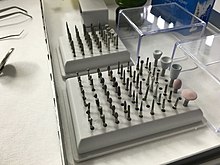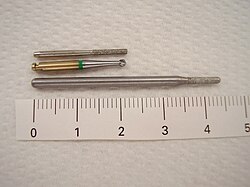Rotating dental instruments
Rotating dental instruments (hereinafter referred to also drill called) are differently designed and equipped approaches that are identified by the ISO numbering system (ISO 6360) and dental angle or handpieces or turbines are clamped - the drills at a drill comparable. The handpiece drills also fit into the technical handpieces commonly used in dental technology.
The rotating instruments are differentiated according to
- the material of the working part (1st - 3rd digit of the ISO number),
- the shaft (diameter and total length) (4th to 6th digit of the ISO number),
- the shape of the working part (7th-9th digit of the ISO number),
- the execution of the working part (10th-12th digit of the ISO number),
- the size of the working part (diameter) (13th – 15th digit of the ISO number) and
- the scope.
General
The sections of the drill can be divided into head, neck and shaft , with the head representing the working part and the shaft being used for fastening in the drive.
Sharpness, material hardness and concentricity are important features for the quality of the drill. The accuracy of the shape of the instruments is just as important if they are used subsequently.
The drills are marked with color markings, which provide information about the diamond grain and the toothing properties.
used material
steel
Steel instruments consist of a tungsten - Vanadium - alloy (ISO number: 310) or stainless steel (ISO number: 330) and are made of one piece. They are particularly sharp when new, but lose their sharpness comparatively quickly. They are primarily suitable for working on dentine , i.e. for excavating (drilling out) carious defects. Also milling for processing gypsum and plastics are made of steel, as well as bone milling (z. B. Lindemann milling ). Today steel instruments (stainless) are used almost exclusively in oral surgery and implantology. In the treatment areas of filling therapy and crown and bridge restorations, diamond and hard metal instruments are more commonly used.
hard metal
Carbide drills (ISO number: 500) are made of highly compressed fine-grain carbide. They are harder than steel drills and therefore have a longer service life without significantly losing their sharpness. They can be used for the same purposes as the steel drill bits, but because of their hardness they are also suitable for removing metal fillings ( amalgam fillings ) or metal crowns and bridges . Disadvantage: They are more brittle than steel drills, which means an increased risk of breakage.
Steel or hard metal instruments with a fine toothing are called finishers and are used for smoothing.
diamond
Diamond-coated instruments (diamond - ISO number: 806; sintered diamond - ISO number: 807) have a core made of stainless steel, which is coated with diamond grains by electroplating , with different grain sizes available. The classification and color coding of the grain sizes is specified in DIN EN ISO 7711-3. They are primarily used to process the tooth enamel , i.e. when preparing the teeth for the provision of tooth crowns and filling cavities. They are almost exclusively available with an FG (Friction Grip) shank (see below) and are particularly suitable for dental turbines and special (high-speed) contra-angle heads.
Ceramic abrasives
Ceramic abrasives also have a hardened steel core. Using a binding agent, this is equipped with grains of high-grade corundum (ISO number: 625) or silicon carbide (ISO number: 655). They are only used in exceptional cases to process hard tooth substances , but rather to process metals, e.g. B. the filling or denture correction .
Elastic polishers
With elastic polishers (also called rubber polishers ), ultra-fine grinding and polishing agents with a binding agent made of polysiloxane and rubber are mounted on a shaft made of stainless steel. With their fine-tuning they are suitable for polishing the surface of plastics, ceramics, precious metals, model casting, titanium, filling materials, but also natural teeth.
Shafts
The shaft types are classified according to DIN EN ISO 6360-1. The standard describes the shafts with a three-digit code (XXX), whereby the first two digits describe the type and diameter of the shaft used: 10 = handpiece shaft ø 2.35 mm; 20 = contra-angle shank ø 2.35 mm; 31 = FG shank ø 1.60 mm.
The third digit of the code describes the qualitative length ratio of the same shaft types to each other: 2 = very short, 3 = short, 4 = normal, 5 = long, 6 = extra long
Example: A contra-angle shank with normal length is named "204" according to DIN EN ISO 6360-1. Longer instrument shafts can be 205 or 206.
FG shank
The term FG-shaft comes from the English : F riction G rip ("static friction"). The FG shaft is smooth and has a standardized diameter of 1.6 mm. FG shanks fit into dental turbines and special (high-speed) contra-angle heads. The instruments (here example round drills) can have different overall lengths: from short (16 mm) to normal and long to extra long (25 mm).
Elbow Shank (RA)
The contra-angle shaft is also known as the RA shaft (from English : R ight A ngle ). It is usually locked manually in the contra-angle head and therefore has a notch at the end of the shaft. RA shafts have a diameter of 2.35 mm and a total length between 22 mm and 34 mm.
The total length of the instruments is influenced by the working part length, i.e. H. a contra-angle handpiece with shank type 204 can have a longer working part and a greater overall length than the corresponding round drill.
Handpiece shaft (HP and HPT)
Handpiece shafts ( HP = H and P iece ) also have a diameter of 2.35 mm and are between 34 mm and 70 mm long. They have no notch, they are attached by a chuck in the handpiece.
For dental technology handpieces, there are also thick shafts ( HPT = H and P iece T hick ) with a diameter of 3.0 mm and a length of 34 mm and 44.5 mm.
Shape of the working part, areas of application and speeds
Steel and carbide
Almost all instrument forms are available in different sizes, which are classified according to ISO 2157.
One of the most widely used and versatile instruments is the round drill, which is also known as the round drill . This, as well as the wheel drill, the inverted cone, the fissure drill and other steel or hard metal drills not shown here are used for excavating (removing or "drilling out" carious tooth hard substances ), whereby wheel drills and inverted cones serve in particular to prepare undercuts to anchor plastic filling material . But metals and plastics can also be processed with it.
Finishing tools are used to smooth the surface, surgical instruments (e.g. Lindemann cutters) for processing bones, and plaster and plastic cutters for working out models and prostheses.
The instruments shown should be used at a speed between 5,000 min −1 (revolutions per minute) and 40,000 min −1 .
Special instruments belonging to the implant system used are used before dental implants are inserted . This specially adapted to the diameter and length of the implants drills are at very low speed (2,000 min -1 used) to the implant in the bone to prepare. Some of these instruments have what is known as internal cooling, in which physiological saline solution is fed through a small channel through the shaft directly to the working tip in order to flush out bone chips or tissue remnants and to avoid overheating and thus damage to the bone (thermal necrosis).
Diamonds
Diamonds are also suitable for working on very hard tooth enamel . They are therefore primarily used to prepare filling cavities and teeth for receiving crowns. There are diamonds of different grits on the market. This z. B. a tooth stump can be smoothed before the impression . Many manufacturers mark the grain size with colored rings.
The processing of metals with diamonds is not advisable because they then “smear”, lose their sharpness and quickly become unusable.
For smaller diamonds full speed dental turbines may be up to 400,000 min -1 are utilized. For diamonds with a larger diameter, the speed must be reduced, because otherwise the enormous centrifugal forces can lead to the instrument breaking. At these high speeds, cooling with water (spray) is absolutely necessary because very high temperatures occur at certain points, which would damage the tooth.
Ceramic abrasives
Ceramic grinding tools (also called stones ) are used to finish and smooth workpieces (especially model cast prostheses and other (precious) metal work). They are available in different grain sizes, which can be recognized by their coloring. Natural teeth and dentures can also be processed well with ceramic grinding tools to B. Correct the occlusion .
The optimum speed is depending on the material to be machined from 20,000 min -1 to 50,000 min -1 .
Elastic polishers
Elastic polishers (also called rubber polishers ) are used as the final step in finishing before high-gloss polishing with polishing paste. The workpiece can get very hot.
Their optimal effect they achieve, depending on the grain and the workpiece at a speed between 5,000 min -1 and 20,000 min -1 .
Other forms
There are a multitude of other forms for every purpose of dental and dental technical work: Disc-shaped, bud-shaped, pear-shaped, lens-shaped, flame-shaped, chalice-shaped etc. Also mandrels as carriers for (diamond-coated) cutting discs and emery paper carriers as well as felt cones, goat hair brushes and linen dabbing as carriers for pumice powder are available.
Root canal instruments
In addition to hand instruments, machine-operated rotating instruments are also available for root canal treatments : Giro files, Hedstroem files, reamers, but above all root fillers (Lentulo, named after Henri Lentulo ). These instruments, some of which have to be operated with special contra-angle handpieces, are available in many strengths (indicated by colored rings) and different lengths.
swell
- Walter Hoffmann-Axthelm: Lexicon of Dentistry , Quintessenz-Verlag, Berlin
See also
Web links
Individual evidence
- ↑ a b c d Information from several well-known manufacturers
- ↑ Hans H. Caesar: The training to become a dental technician, page 531 ff.
- ↑ Hans H. Caesar: The training to be a dental technician, page 532 ff.
- ↑ Hans H. Caesar: The training to be a dental technician, page 546
- ^ Karl-Heinz Danger: Rotating tools in the dental laboratory






